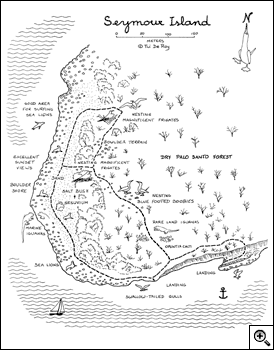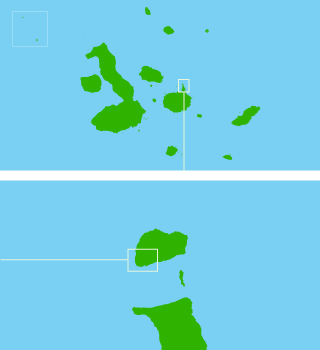

| NORTH SEYMOUR |
North Seymour Island |

Permitted Uses:  Interpretive Group Tour with a Naturalist Guide Interpretive Group Tour with a Naturalist Guide  Photography and filming Photography and filming  Guided walks Guided walks  Associated Activities authorized by the GNPS in the itineraries of Authorized Vessels Associated Activities authorized by the GNPS in the itineraries of Authorized Vessels

|
North Seymour is located north of Baltra (or South Seymour). The total distance of the trail is 2 miles.
Seymour North, Plaza Sur and Plaza Norte, Baltra, northeastern Santa Cruz, Santa Fe and part of Española, were formed by uprisings of underwater volcanic lavas. They were part of a volcanic lava table deposited in sheet form along cracks located on the ocean floor. The uprisings occurred sporadically and lasted more than a million years to reach its current level.
All marine fossils found in the archipelago are found in these islands and the best example is the North Channel side of Baltra. The fossils date from the Pleistocene, and specifically in the case of Baltra, one can say that these volcanic tables were close to the surface about a million years ago.
|
|

Click on the illustration to enlarge.
|
All marine fossils found in the archipelago are found in these islands and the best example is the North Channel side of Baltra. The fossils date from the Pleistocene, and specifically in the case of Baltra, one can say that these volcanic tables were close to the surface about a million years ago.
In 1932 and 1933, about 72 land iguanas from Baltra were introduced to North Seymour by Captain Alan Hancock and his crew; with the intention that these animals could survive in better condition than in Baltra, already populated by goats. The iguanas that the crew of Valero III (Hancock's ship) found at Baltra were undernourished. It was discovered in 1934 that the iguanas had colonized the island without problems. Later, during the Second World War when the United States occupied Baltra to install a military base, the land iguanas, which still existed there, disappeared as their habitat was altered for the construction of runways and barracks for soldiers. Besides the presence of goats, dogs and cats. In 1980, two adults were taken to the breeding center at the Darwin Station's initiating the program of reproduction and rearing of land iguanas in captivity; and in 1985 eight more adults were transported and from these 80 youth were acquired by 1990. (For more information on the subject, read Arturo Izurieta's thesis,"Ecology of the Iguanas on North Seymour Island, 1991).
By the end of 2008, 600 iguanas have been accounted for on North Seymour, of which 400 have been repatriated and 200 were born in the wild. In contrast, on Baltra Island, the population has surpassed the 1,500 samplings.
The vegetation is bush and hosts the largest nesting colony of Great Frigatebirds in Galapagos. Importantly, the Galapagos is the westernmost distribution for this species. The common frigate is also present.
Special Indications
-
The frigates here are surly and its preferable to keep some distance from the nests. Do not let your visitors leave the trail for a closer look at these birds, especially in the breeding season.
-
Sometimes blue-footed boobies and swallow-tailed gulls nest along the path, there is no need to open other paths. We must always keep the group on the trail and finding birds nesting there, requires walking slowly to avoid disturbing them.
-
Watch that tourists who are in your care do not disturb the nesting iguanas.
|


![]()


![]()